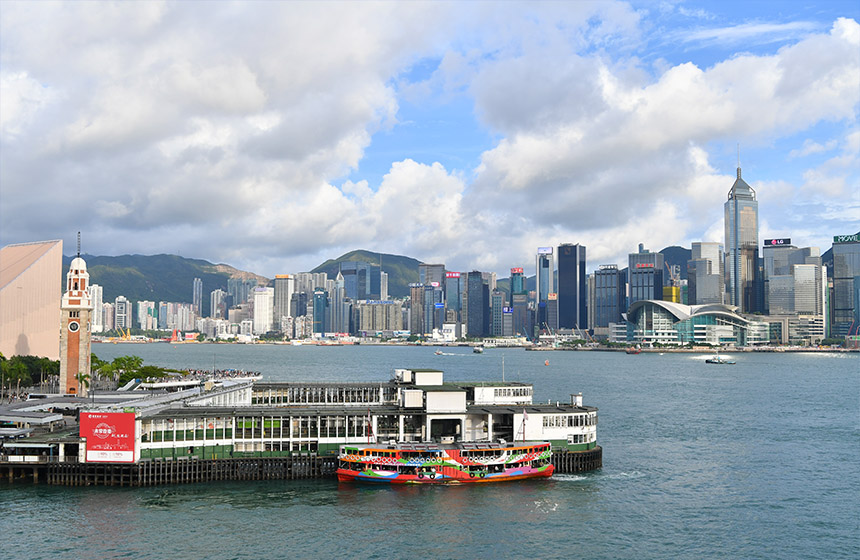Major Social and Economic Indicators (2023)

| Area | 1 115km2 |
|---|---|
| Population | 7 536 100 |
| Gross domestic product (GDP) | HK$2,981.6 billion |
| GDP per capita | HK$396,000 |
| Value of total merchandise trade | HK$8,822.4 billion |
| Value of export | HK$4,177.4 billion |
| Value of import | HK$4,645 billion |
| Industrial structure (% of GDP)* | Primary industry (agriculture, forestry, animal husbandry, fishery):
0.1% of GDP Secondary Industry (industrial and construction): 6.5% of GDP Tertiary industry (service industry): 93.5% of GDP |
| Port Cargo Throughput | 175 million tons |
| Passenger Throughput | Visitor Arrivals to Hong Kong: 34 million passenger trips Hong Kong International Airport: 39.491 million passenger trips |
Note: the above figures are provided by relevant department of the Hong Kong SAR Government
* 2022 data
- Located on the southern coast of the country and heart of Asia, Hong Kong enjoys fortuitous geographic advantage and is a world city leveraging on the Mainland while engaging the world. Hong Kong is well connected to Asia's key markets, making it an ideal location for businesses to tap into the multitude of opportunities in the Mainland and Asia-Pacific region.
Impressive international reputations
- Hong Kong was ranked by Canada's Fraser Institute first globally in its Economic Freedom of the World: 2024 Annual Report.
- Hong Kong ranked third in the World Economic Forum's 2019 Global Competitiveness Report, up four places.
- Hong Kong ranked the third easiest place to do business by the World Bank's Doing Business 2020 Report, up one place from last year.
- Hong Kong ranked third in the Global Financial Centres Index (GFCI) 36 Report published by the Z/Yen from the United Kingdom and the China Development Institute from Shenzhen.
- Hong Kong was recognised by the International Institute for Management Development World Competitiveness Yearbook 2024 as the fifth most competitive economies in the world.
- According to the World Trade Organization, Hong Kong ranked the tenth largest trading entity in the world in 2023.
Hong Kong's unique advantages in the Greater Bay Area
- Being the most international city in the Greater Bay Area, Hong Kong has a business-friendly environment, good tradition of the rule of law, free economic system, and well-established information technology infrastructure and financial system, as well as a wealth of high-end talents and professional services with extensive knowledge on global markets.
- The Dedicated Chapter on Hong Kong and Macao in the Outline of the 13th Five-Year Plan for the National Economic and Social Development of the People's Republic of China (the 13th Five-Year Plan) acknowledges the functions and positioning of Hong Kong in the development of our country which includes the support for Hong Kong in consolidating and enhancing our status as international financial, shipping and trade centres; strengthening our status as a global offshore Renminbi business hub and an international asset management centre; and promoting financing services, business and commerce, logistics and professional services, etc. towards high-end and high value-added development. The 13th Five-Year Plan also supports Hong Kong in developing the innovation and technology industry, nurturing emerging industries, as well as establishing itself as a centre for international legal and dispute resolution services in the Asia-Pacific region. Moreover, the 13th Five-Year Plan supports Hong Kong in participating in the country's two-way opening up, as well as the Belt and Road Initiative and encourages enterprises from the Mainland, Hong Kong and Macao to leverage their respective advantages and adopt various collaborative approaches to "go global" together. Hong Kong will leverage its unique advantages to form complementary functions with other cities in the Greater Bay Area, extending the scope to the international arena and leading to the integration of the Greater Bay Area development and the Belt and Road Initiative.
Transportation and logistics hub
- With a sound transport system and world-class infrastructure, Hong Kong is an international and regional transportation and logistics hub and is committed to developing into a cruise hub in the region.
- In the area of air transport services, Hong Kong International Airport (HKIA) is one of the world's busiest airports in terms of international passenger and cargo throughput. It has been frequently ranked one of the world's best airports. Hong Kong is within a four-hour flight from Asia's key markets and a five-hour flight from half the world's population. In the area of maritime services, Hong Kong is one of the busiest container ports in the world in terms of container throughput. Benefiting from Victoria Harbour's deep waters, no air draft limit and well-equipped cruise berthing facilities, the Kai Tai Cruise Terminal serves the world's largest cruise liners.
- Being well-versed in operation and regulations of international trade and possessing talents and international network, Hong Kong has been thriving in high value-added professional maritime services. On aviation, HKIA is a mature international and regional aviation hub with a well-established network of international air routes. Leveraging the advantage of an international maritime centre, Hong Kong will drive other Greater Bay Area cities to build a world-class harbour and airport cluster as well as a cluster for high-end maritime service industries in the Asia-Pacific region for the Belt and Road Initiative.
Cross-boundary infrastructure
The commissioning of three significant transport infrastructure projects, namely the Hong Kong-Zhuhai-Macao Bridge (HZMB), the Hong Kong Section of the Guangzhou-Shenzhen-Hong Kong Express Rail Link (XRL) and Liantang/Heung Yuen Wai Boundary Control Point (LT/HYW BCP) will substantially reduce travelling time between Hong Kong and other Greater Bay Area cities, and vastly improve the transport connectivity within the Greater Bay Area, thereby creating a highly accessible Greater Bay Area as well as connecting the Greater Bay Area to the world. This will consolidate Hong Kong's status as international financial, transportation and trade centres as well as an international aviation hub.
- HZMB
- The HZMB will significantly reduce transportation costs and time for travellers and goods. For example, the travelling time between the Kwai Tsing Container Terminal and Zhuhai will be reduced from currently three and a half hours or so to about 75 minutes, whilst the travelling time between the Hong Kong International Airport and Zhuhai will be reduced from currently four hours or so to about 45 minutes.
- The Western Pearl River Delta (PRD) will fall within a reachable three-hour commuting radius of Hong Kong, enhancing the city's position as a trade and logistics hub as goods from the Western PRD, Western Guangdong and Guangxi can better make use of the airport and container ports in Hong Kong. The HZMB will accelerate the economic integration of the PRD and its neighbouring provinces.
- Hong Kong Section of the XRL
- Scheduled to be commissioned in September 2018, the Hong Kong Section of the XRL will connect Hong Kong with the over 30 000-km National High Speed Rail Network.
- The travelling time from the West Kowloon Station in Hong Kong to Shenzhen, Guangzhou as well as other cities in the PRD region will be greatly shortened, taking only about 14 minutes to Futian, 18 minutes to Shenzhen North and 46 minutes to Guangzhou South. Passengers can also reach other Greater Bay Area cities through onward transfer to the PRD Intercity Rapid Transit.
- LT/HYW BCP
- The LT/HYW BCP will be the first road-based BCP in Hong Kong with direct access facilities for both passengers and vehicles. It connects with the Eastern Corridor to Longgang in Shenzhen and further extends to the eastern part of Guangdong Province via the Shenzhen-Huizhou Expressway (also known as Huizhou-Yantian Expressway) or Shenzhen-Shantou Expressway, providing a direct and efficient cross-boundary access to eastern Shenzhen, Huizhou, eastern Guangdong as well as the neighbouring provinces.
- Upon the full commissioning of the LT/HYW BCP and Eastern Corridor, the average travelling time between Tai Po of Hong Kong and Longgang of Shenzhen would be shortened by about 22 minutes.
Economic and Trade Relations between Hong Kong and the Mainland
- Hong Kong has long been leveraging its unique advantages to enhance its role and functions in the process of the country's economic development and opening up of its economy. It continues to serve as a gateway for multinational companies accessing the Mainland market and as an important platform for Mainland companies seeking to expand overseas.
- In terms of trade, Hong Kong and the Mainland are each other's major trading partners. Since the reform and opening up of the country, the Mainland's share of Hong Kong's global trade had increased significantly from 9.3% in 1978 to 49.2% (HK$4,342.7billion) in 2023.
- Hong Kong was the Mainland's fourth largest trading partner in 2023, and their total trade value accounted for 4.9% of the Mainland's total trade. Hong Kong was the Mainland's second largest export market, taking up 8.1% (HK$2,135.7 billion) of its total exports in 2023.
- The value of Hong Kong's total imports from the Mainland was HK$2,022.3 billion, accounting for 43.5% of Hong Kong's total imports in 2023. Meanwhile, the Mainland was Hong Kong's largest domestic export market, absorbing HK$25 billion worth of goods. In 2023, the value of goods re-exported through Hong Kong from and to the Mainland was HK$3,432.2 billion, accounting for 83.5% of Hong Kong's total re-export trade value.
- In terms of investment, the Mainland was Hong Kong's second largest source of inward direct investment. At end-2022, investment from the Mainland accounted for about 30% of the total stock of Hong Kong's inward direct investment which was equivalent to HK$4,705.1 billion.
- Mainland companies also maintain a strong presence in Hong Kong. As at mid-2023, Mainland companies had established 2 177 regional headquarters and regional or local offices in Hong Kong.
Key areas of work
- To consolidate and enhance Hong Kong's status as international financial, transportation and trade centres as well as an international aviation hub;
- To develop an international innovation and technology hub;
- To expand the scope of development for sectors in which Hong Kong's strengths lie;
- To strengthen infrastructural connectivity;
- To foster youth innovation and entrepreneurship; and
- To fully utilise Hong Kong's international connections and networks to promote the Guangdong-Hong Kong-Macao Greater Bay Area overseas and attract capital and talents to the Greater Bay Area.
